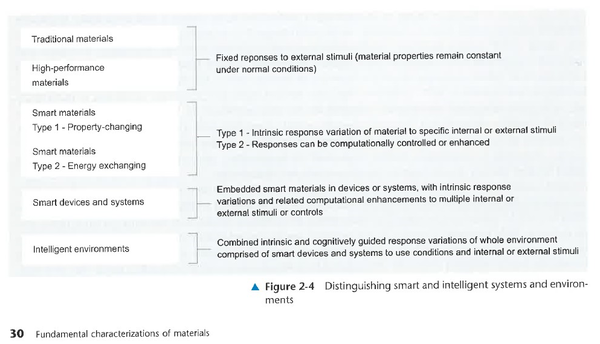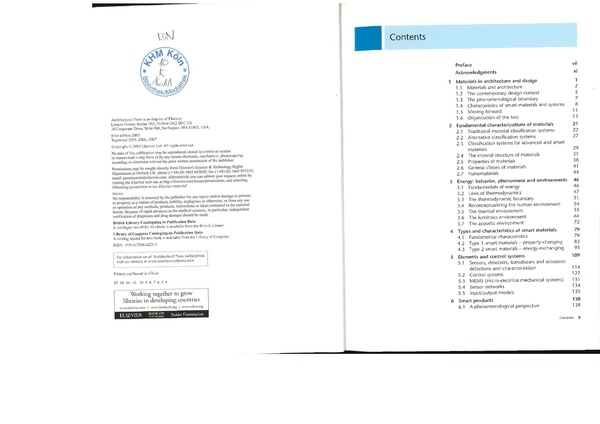Smart Materials and Technologies
Aus exmediawiki
Zurück zu Bücher
Auszüge aus dem Inhaltsverzeichnis
1.4 - Characteristics of smart materials and systems
"Whether a molecule, a materials, a composite, an assembly, or a system, 'smart materials and technologies' will exhibit the following characteristics:
Immediacy - they respond in real time
Transiency - they respond to more than one environmental state
Self-actuation - intelligence is internal to rather than external to the 'material'.
Selectivity - their response is discrete and predictable.
Directness - the response is local to the 'activating' event"
2 - Fundamental characterizations of materials
- Traditional material classification systems
- Alternative classification systems
- Classification systems for advanced and smart materials
- The internal structure of materials
- Properties of materials
- Generals classes of materials
- Nanomaterials
3 - Energy : behaviour, phenomena and environments
3.7 - The acousic Environment
4 - Types and characteristics of smart materials
- Fundamental characteristics
- Type 1 smart materials - property-changing
TYPE 1 MATERIALS
Based on the general approach described above, smart materials may be easily classified in two basic ways. In one construct we will be referring to materials that undergo changes in one or more of their properties - chemical, mechanical, electrical, magnetic or thermal - in direct response to a change in the external Stimuli associated with the environment surrounding the material. Changes are direct and reversible - there is no need for an external control system to cause these changes to occur. A photochromic material, for example, changes its color in response to a change in the amount of ultraviolet radiation on its surface. We will be using the term 'Type 1' materials to distinguish this class of smart materials. Chapter 4 will discuss these materials in detail. Briefly, some of the more common kinds of Type 1 materials include the following:
• Thermochromie - an input of thermal energy (heat) to the material alters its molecular structure. The new molecular structure has a different spectral reflectivity than does the original structure; as a result, the material's 'color' - its reflected radiation in the visible range of the electromagnetic spectrum - changes.
• Magnetorheological - the application of a magnetic field (or for electrorheological - an electrical field) causes a change in micro-structural orientation, resulting in a change in viscosity of the fluid.
• Thermotropic - an input of thermal energy (or radiation for a phototropic, electricity for electrotropic and so on) to the material alters its micro-structure through a phase change. In a different phase, most materials demonstrate different properties, including conductivity, transmissivity, volumetric expansion, and solubility.
• Shape memory - an input of thermal energy (which can also be produced through resistance to an electrical current) alters the microstructure through a crystalline phase change. This change enables multiple shapes in relationship to the environmental stimulus.
TYPE 2 MATERIALS
A second general class of smart materials is comprised of those that transform energy from one form to an output energy in another form, and again do so directly and reversibly. Thus, an electro-restrictive material transforms electrical energy into elastic (mechanical) energy which in turn results in a physical shape change. Changes are again direct and reversible. We will be calling these 'Type 2' materials. Among the materials in this category are piezoelectrics, thermoelectrics, photovoltaics, pyroelectrics, photoluminescents and others.
Chapter 4 will also consider these types of materials at length. The following list briefly summarizes some of the more common energy-exchanging smart materials.
• Photovoltaic - an input of radiation energy from the visible spectrum (or the infrared spectrum for a thermo-photovoltaic) produces an electrical current (the term voltaic refers more to the material which must be able to provide the voltage potential to sustain the current).
• Thermoelectric - an input of electrical current creates a temperature differential on opposite sides of the material. This temperature differential produces a heat engine, essentially a heat pump, allowing thermal energy to be transferred from one junction to the other.
• Piezoelectric - an input of elastic energy (strain) produces an electrical current. Most piezoelectrics are bi-directional in that the inputs can be switched and an applied electrical current will produce a deformation (strain).
• Photoluminescent - an input of radiation energy from the ultraviolet spectrum (or electrical energy for an electroluminescent, chemical reaction for a chemoluminescent) is converted to an output of radiation energy in the visible spectrum.
• Electrostrictive - the application of a current (or a magnetic field for a magnetostrictive) alters the inter-atomic distance through polarization. A change in this distance changes the energy of the molecule, which in this case produces elastic energy - strain. This strain deforms or changes the shape of the material.
Scans


